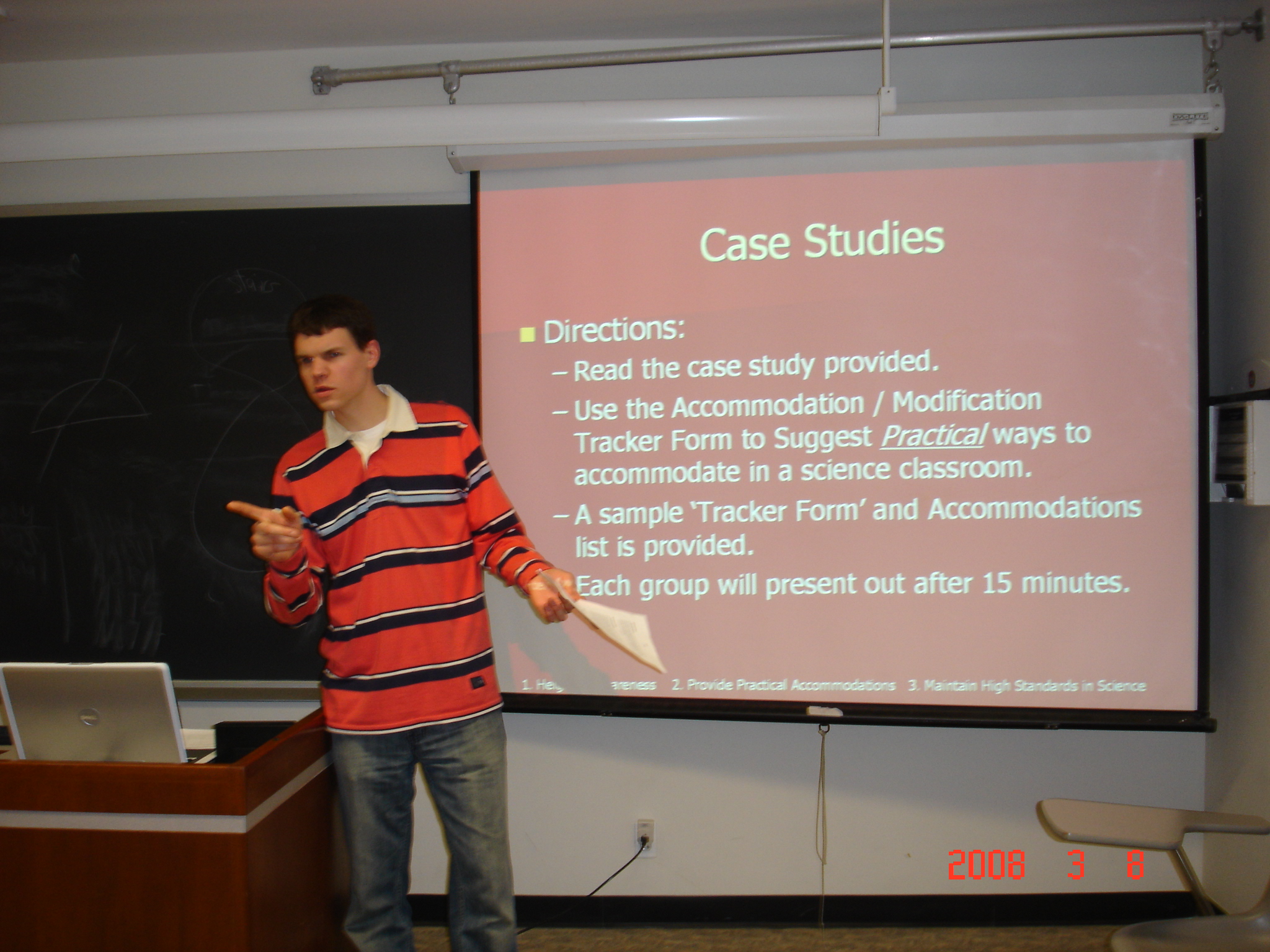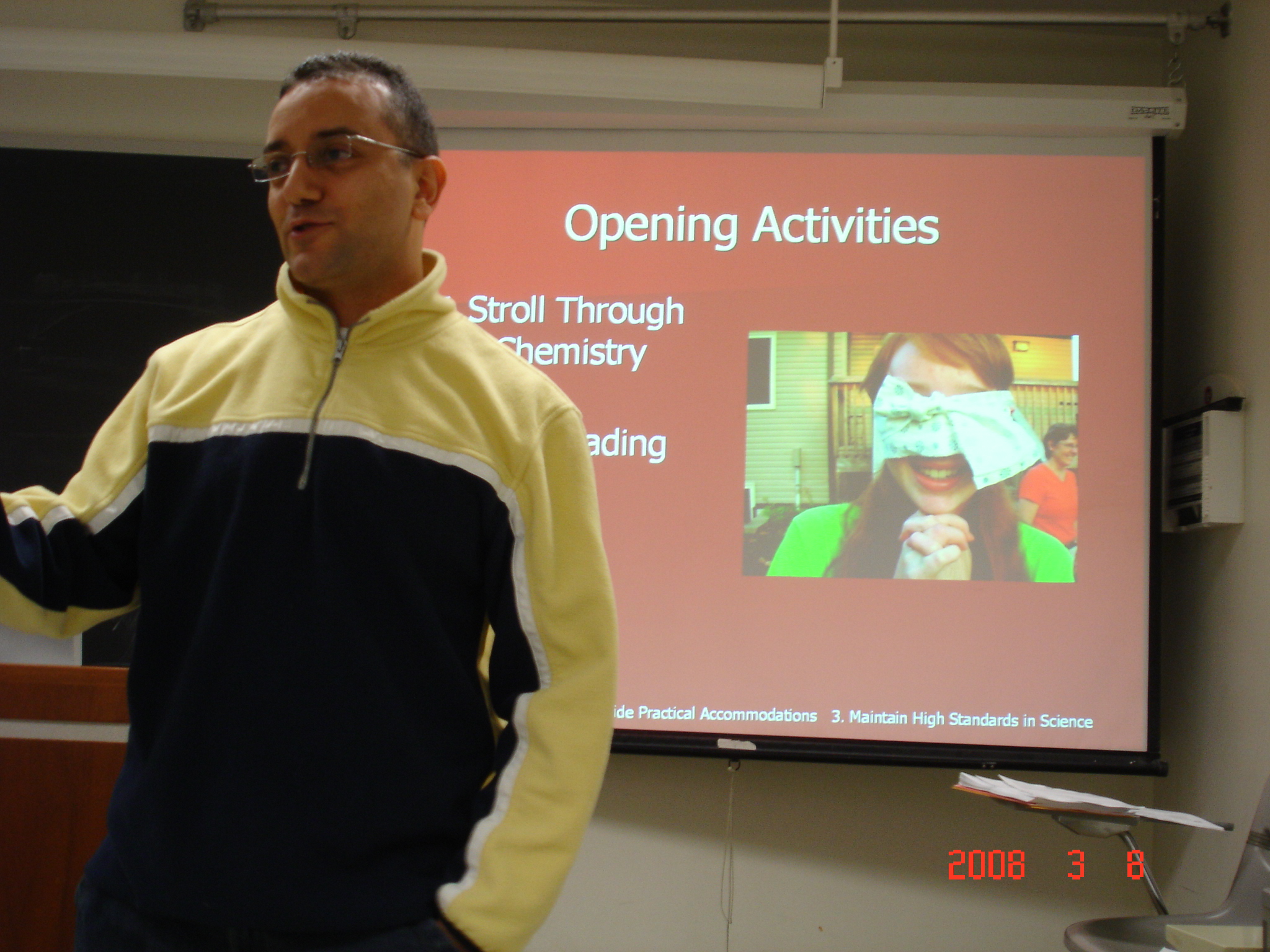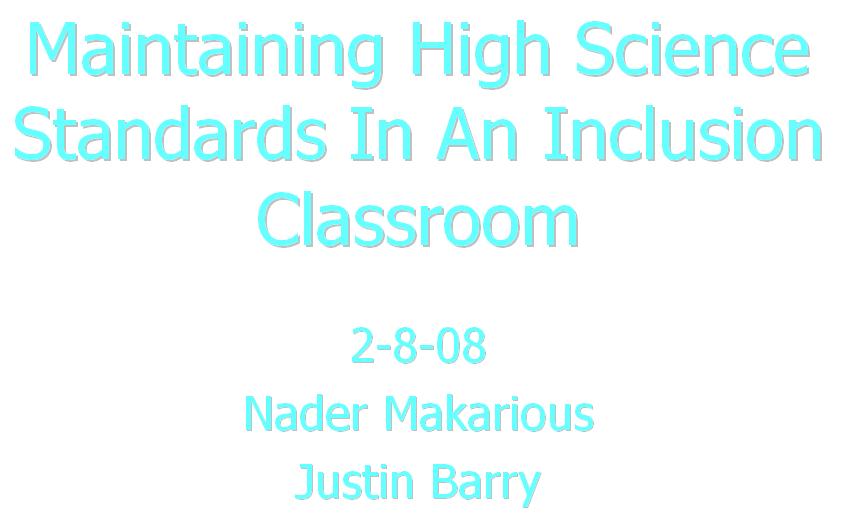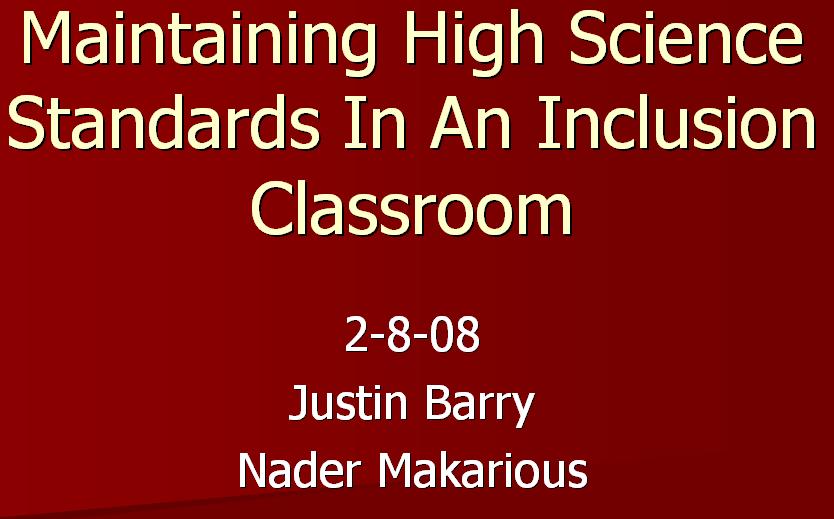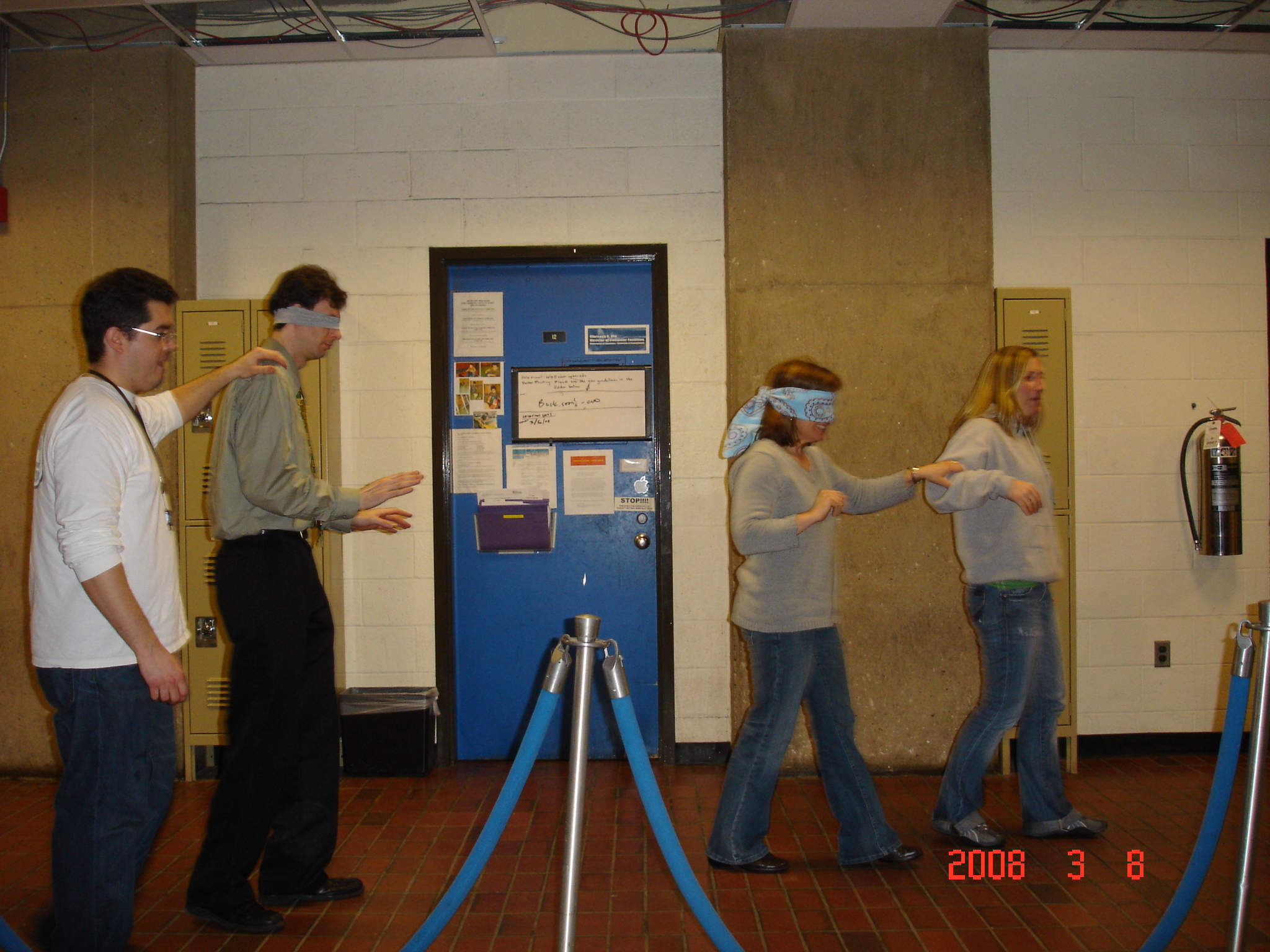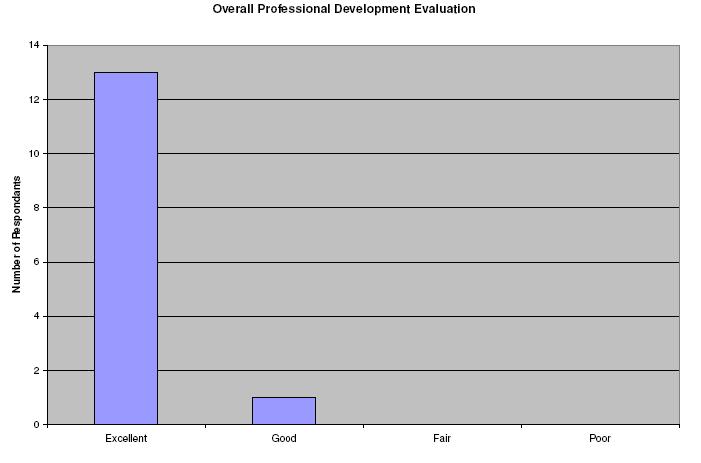
| Home | UPenn E-Portfolio | CHEM
501 |
CHEM 502 |
CHEM 503 |
EDU 536 |
CHEM 505 |
CHEM
506 |
CHEM 507 |
EDU 636 |
CHEM 504 |
CHEM 508 |
| Reflection
#7b |
| <--Previous Reflection Next Reflection--> |
Reflection On Our Professional Development
Maintaining High Science Standards
In An Inclusion-Based Classroom
by Justin Barry and Nader Makarious
|
Introduction:
| Science
education is much more multifaceted than most teachers
presume. Beyond mere curriculum, there is a diverse set of
students in
each class, which have many needs. There are several students in
our
high school classes that have disabilities, which are difficult to
address. Meeting students' individual needs while maintaining
high
science standards can be difficult. We choose to
focus our
professional development on helping teachers adapt science content
while keeping expectations high. Many of our cohort members
experience
similar circumstances, teaching students with disabilities. In
Figure 1, Justin is introducting the professional development and
stating the goals (see below). |
|
|
Our presentation began with an interactive powerpoint presentation, demonstrating how several of our own cohort members had disabilities. We then had groups of two people team up, with one cohort member blindfolded, in order for each student to feel what it was like to have a disability. Awareness of disabilities was further heightened with a special translation of the three bears story (see below for translation). We told personal stories from our classroom, where we have seen students succeed in the science classroom from practical accommodations that have been made. A sample case study and practical accommodations were presented. Group discussion and an accommodations tracker became the tools to find the best way to help the student achieve in a science classroom. Lastly, a lively class discussion followed on how to accommodate in the science classroom.
Below you will find each piece of the professional development laid out in sequential order according to the three goals we have chosen. The results of an evaluation of our professional development was conducted and are included on this page. Finally, at the bottom of the page is how this professional development meets the Penn STI Enduring Understandings and e-portfolio rubric criteria.
|
|
During the concurrent Molecular
Spectroscopy class, Chemistry 507,
we found that two of our
colleagues from our cohort were color blind. As a result, we
chose to
start our presentation
with a blue-lettered and white background powerpoint slide (Figure
3).
The two colorblind cohort members could not see the information of the
slide because of there disability. They felt a sense of
discomfort
and isolation, being the only individuals who could not read nor
understand what was happening. A regular slide (Figure 4) was
then
placed on the screen to create an equal environment for everyone.
Nader (Figure 2) addresses the disabilities we all have and experience
with our students. |
|
|
|
Activity 1: A stroll through the
chemistry building
|
|
We divided the class into two
main groups. Each group took a blindfolded partner through the
chemistry building. After three minutes, the pair switched roles
to lead a colleague through
the chemistry building in the shape of the number eight-weaving around
rooms, over steps, and through doors (See Figure 5). |
Activity 2: The story of three little bears
|
Being blind was an extreme
disability that most teachers do not experience everyday in their
classrooms. Therefore, our
second activity gave our colleagues the feeling of a struggling reader
and to realize their individual needs. The story was based on The Three Bears; however, it was
written using dyslexic language (see Figure 7). Many letters were
misplaced and exchanged. Having the colleagues translate the text
(see Figure 6) was a very effective way to feel the daily
struggle of
challenged students who take much more time to read a short passage.
Many students who are in science classes are struggling to read, to
comprehend information, and solving problems all at once. |
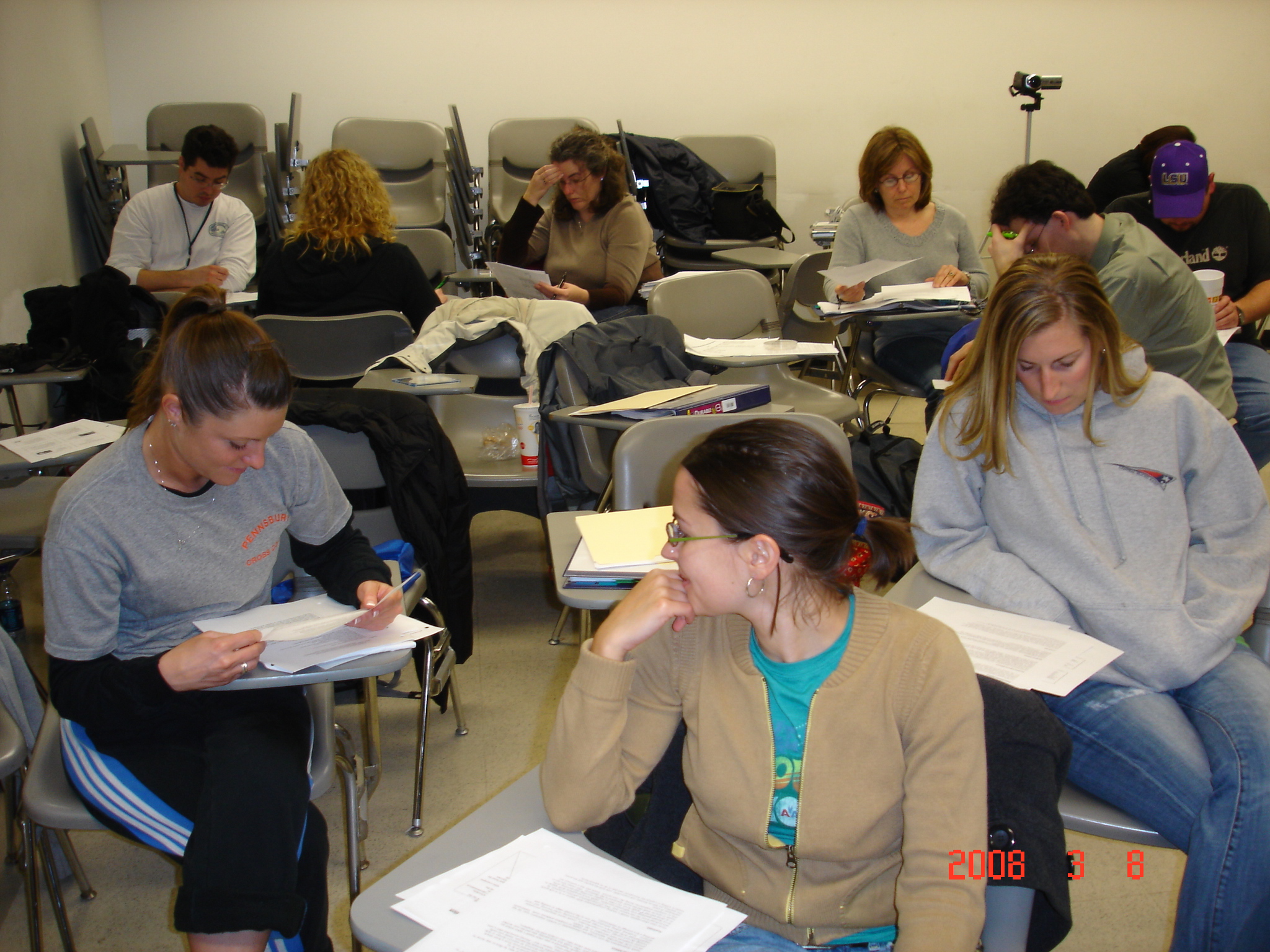 Figure 6. Colleagues translating "The Three Bears" in groups. |
Goal #2: Provide Practical Accommodations &
Goal #3: Maintain High Science Standards:
|
Our next two goals of our professional development was to provide our colleagues with the ability to accommodate in their science classroom while maintaining high science standards. We provided an accommodation tracker, which served as a basic temple one can put accommodations on to meet the individual needs of each student. The case study of Isaiah provided a practical example of a science student who needed accommodations provided to him. The class was divided into three groups of six individuals. The emotional and learning disabilities of Isaiah were provided. In addition, short practical accommodations were given as a starting place to address methods of instruction, assessment, and learning environment. Each group was responsible to create a list of accommodations (Figure 8) for the students and report their findings to the whole class. A lively discussion followed the practical suggestions from our colleagues. Many issues were discussed including how to encourage students to advocate for themselves in the midst of Individual Educational Plans and mandated supports. |
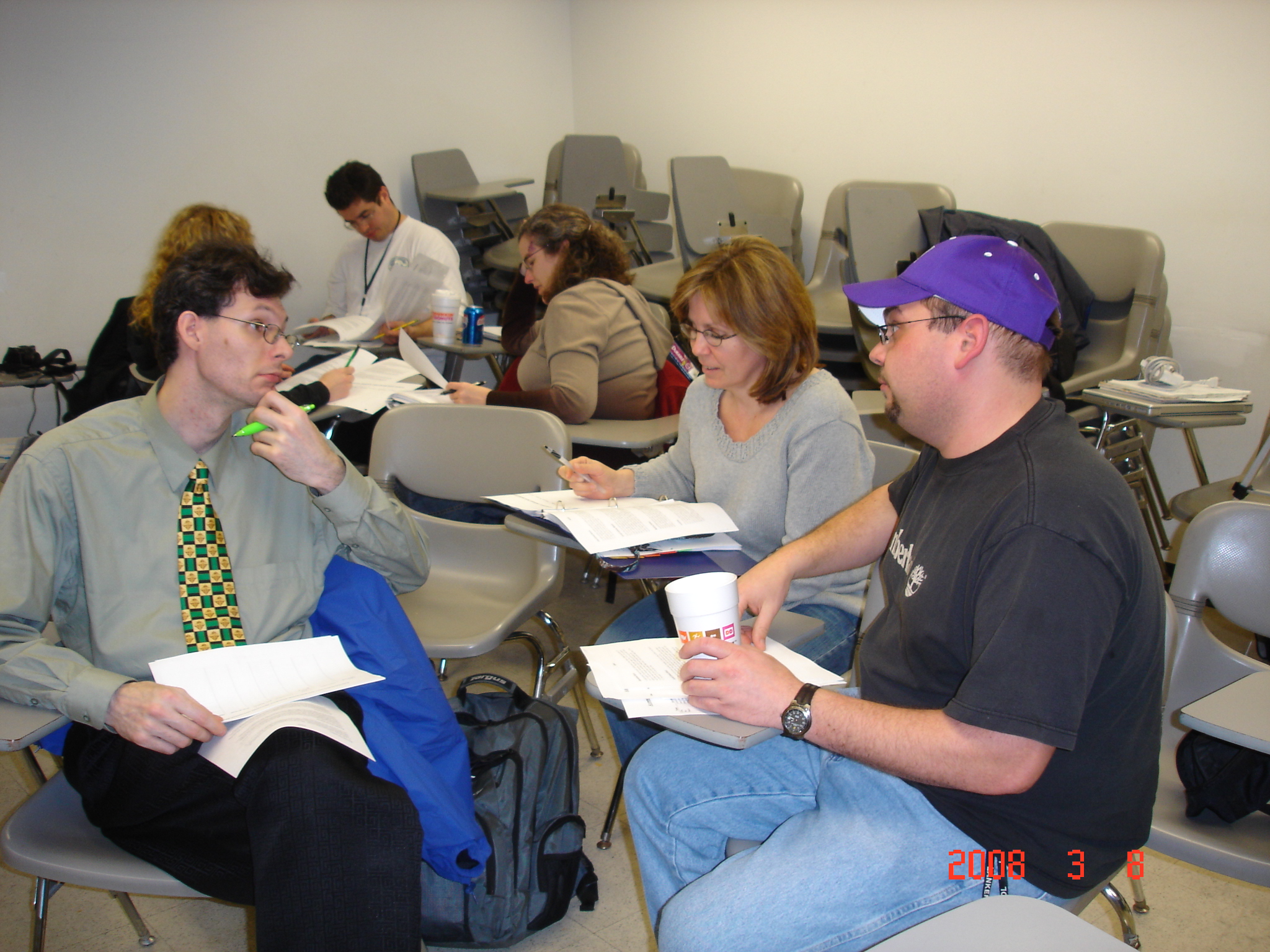 Figure 8. Groups Discussing Accommodations of Sample Case Study. |
Evaluation by Class:
|
|
Excellent |
Good |
Needs
Improvement |
Not
Applicable |
|
Covered Useful Material |
11 |
3 |
|
|
|
Practical To My Needs and
Interests |
10 |
3 |
|
|
|
Well Organized |
13 |
1 |
|
|
|
Presented At The Right
Level |
13 |
1 |
|
|
|
Effective Activities |
13 |
1 |
|
|
|
Useful Visual Aids and
Handouts |
9 |
5 |
|
|
Table 2: Professional Development Evaluation of Presentation
|
Presentation |
Excellent |
Good |
Needs
Improvement |
Not
Applicable |
|
Instructor's Knowledge |
11 |
3 |
|
|
|
Instructor's Presentation
Style |
12 |
2 |
|
|
|
Instructor Covered
Material Clearly |
12 |
2 |
|
|
|
Instructor Responded Well
to Questions |
11 |
3 |
|
|
| Figure 9. |
| Figure 9 shows the overall
effectiveness of the professional development. (Click on Figure 4 for full screen version) |
Conclusion:
- "Nice discussion! Great case studies, very informative."
- "Great job. Liked case studies."
- "Good discussion. Very interesting-relevant information that was not addressed in our classes."
- "It seems we could
have used more time for discussion."
Summary:
This reflection of our professional development met the criteria below in the following way:
Application to EDU 636 Enduring
Understandings:
- Enduring Understanding #7-The
professional educator assumes leadership
roles and communicates with colleagues and other professional educators
the analysis of their own practice (orally and in writing) so that they
become catalytic in improving teaching and learning in their schools,
districts and/or state.
- This professional development assumes leadership roles
and communicates with colleagues how to accommodate scientific
information to meet individual students' needs.
- Enduring Understanding #1-Understanding the connections between socio-cultural and other educational theories and the teaching and learning practices...to support and guide all students with diverse interests, abilities, and experiences in making sense of scientific ideas.
- This professional development supports the EU #1 in
supporting the learning of science in diverse classrooms.
Colleagues are able to more fully meet the needs of students by
accommodating science information.
- Leadership-The participant has grown as a leader in science education
- From the evaluations, comments, and pictures above, leadership was displayed on many levels to improve teaching and learning in our colleagues' schools.
- Reflective Practice-The participant has grown in the ability to apply concepts and scientific principles to practical problems and/or real-world situations.
- Meeting students' needs in our science classroom is
extremely challenging. Reflecting on how to best meet the needs
of academically struggling students and convey that knowledge to my
colleagues demonstrates that I can apply concepts to practical problems.
